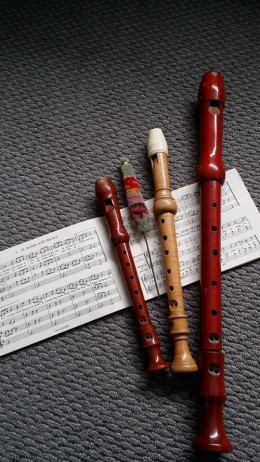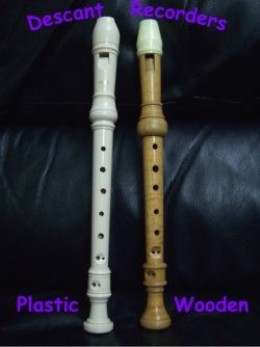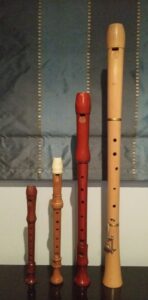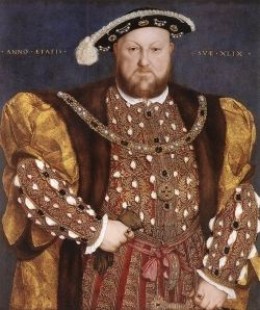Recorder Information
Read on for some background recorder information so you can make an informed decision as to whether you would like to learn it or not and hence take lessons. You will read what the recorder is with its varying sizes, how to play it with examples of fingerings and sound, it’s history with recorder connections to four great historical figures.
By reading these Recorder Facts you can make an informed decision as to whether you want to learn and play this instrument or not.
Don’t forget to click on the highlighted words to find out more information on them.
Ask yourself this whilst reading
Do You Want to Learn The Recorder?
The recorder is a simple woodwind instrument from ancient times and is made of plastic or wood. It comes in a variety of sizes and consists of a straight pipe, 7 finger holes in the front, 1 thumb hole in the back and a detachable beak shaped mouthpiece. It is easy to learn and play a tune. Playing the recorder, like any musical instrument is very relaxing whether it is by yourself, with one other person or in a group.
This instrument is formerly known as ‘English Flute’ or ‘Fipple Flute’. This is because it is derived from the old English verb ‘to record’ which meant ‘sing like a bird’ and it has a fipple, which is the block of wood inserted in the end of the mouthpiece to create the wind pipe.
Recorders of Different Sizes
Recorders come in a range of varying sizes and two different keys of C and F.
Here are just five of them in order of size from smallest to biggest:
– Sopranino in the key of F
– Descant (soprano) in the key of C
– Treble (alto) in the key of F
– Tenor in the key of C
– Bass in the key of F
They all use the same fingering patterns but the notes are named differently for the same fingering depending what key the instrument is in.
Here is an explanation.
The lowest note of the descant and tenor recorders is C and hence they are in the key of C.
This same fingered lowest note in the sopranino, treble and bass recorders is an F and hence they are in the key of F.
But once you are familiar with this you can play the two types quite easily.
Ensembles
You can join a recorder ensemble on any of these instruments and the range of notes covered is like the range of notes you hear from a band or orchestra. However the larger instruments are expensive and harder to handle and so are less often used.
What Sound Does The Recorder Produce?
The sound produced can be described as clear, sweet, birdlike. And the pitch produced varies depending on the size.
Music is written in the bass clef for the bass recorder and treble clef for the other four recorders. The sopranino, descant and bass recorders sound one octave higher than the written music to avoid too many ledger lines. Tenor and treble recorders have music written at the same pitch.
The range of notes played covers two octaves except for the bass recorder which is slightly less.
How Do You Play the Recorder?
Read the two techniques required to play the recorder. On the whole, most people can master both techniques quite quickly and can enjoy playing pieces.
Technique 1: Blowing Over Mouthpiece
Musicians play the recorder by placing the lips over the beak shaped mouthpiece and directing air through the small hole such that it passes over a sharp edge and vibrates in the main tube of the instrument. Sometimes players use their tongue by saying silently “tu” or “du” in order to get clear beginnings to notes. This is called articulation.
Technique 2: Fingering
Recorder players also need to place their finger pads flat over the holes such that no air leaks out, in different orders to produce sounds of different pitch. Each sound or note name has a particular finger pattern called fingering.
Look here at 9 fingerings to start playing the different pitches of sound and musical pieces.
Please note that you can tell if your fingers are placed on the holes properly by pressing firmly on the hole and seeing a round hole mark on your finger or by blowing the desired note and getting it. The sound will be different if air escapes around a hole. Admittedly some young children find getting fingers on the holes properly quite difficult.
What is a Good Age to Begin?
The descant recorder is the most common instrument to start and you can start at any age usually from about the age of 5 and upwards. It is easy to handle and students can get a reasonable sound and play tunes quite quickly. People often learn it for a year or two first before branching out to other instruments. And the musical knowledge gained from learning the recorder first helps make learning another instrument easier.
Types of Music the Recorder Plays
You play many styles of music on the recorder but one reason to learn the recorder today is to revive the playing of old music.
Recorders date back to medieval times ( 500 -1400 ), through the medieval period ( 1400 – 1600 ) and Baroque Period ( 1600 – 1760 ). They were extremely popular in the 16th, 17th and 18th century with music being played from well known composers such as Bach, Telemann and Handel. They declined in popularity from the 18th century in favour of the flute, clarinet and oboe. However it was revived in the 20th century.
There are people interested in the medieval period and form societies with regular social events. At these social events the participants dress up in period costume, partake in a medieval banquet and create music with dancing. So a consort of recorders is formed and medieval music is revived. What better chance to combine two interests of recorder playing with the medieval period.
What is the History of the Recorder?
This instrument was first established as being in existence in the 12th century.
The word ‘recorder’ first appeared in a document in 1388.
There was a publishing of a recorder tutor in Venice in 1535.
In the 15th and 16th century there were several sizes of recorder available which covered a wide range of notes. People in this time were playing these different sized instruments in groups, known as a ‘consort’. Hence the 200 years from 1500 – 1700 was a popular period for this instrument with lots of ‘consort’ playing.
In the 18th century and after Handel died in 1759 the recorder started to decline in popularity and almost died due to the growth of the orchestra. This was due to the fuller tone of the modern flute combining better with the other instruments than the quieter tone of the recorder.
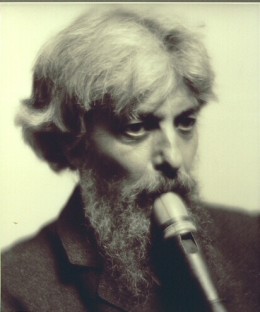
Arnold Dolmetsch
From 1919 Arnold Dolmetsch revived the recorder and is a favourable instrument with amateurs.
And today the recorder is a popular instrument for primary school children to learn as part of their music program.

Three Wooden Recorders
